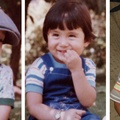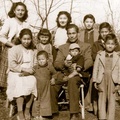In order to give you a better idea of who I am, we can start by saying that I am a product of southern Chile where I was born and raised and where I got my first teaching experience. Within those parameters—even today—Japanese culture was hard to come by, and, very little of it was practiced inside our home. My childhood was defined both by a domineering Chilean mother who ran the same tight ship that she had experienced growing up and a small town setting.
The power of this chilenidad was felt, curiously enough, at the table. White rice (gohan, which is its Japanese name, something I learned much later) was often part of our daily meals, and our salads always featured a pair of “chopsticks” made with colihüe wood (Chilean bamboo) and, even that, I didn’t know its original name. The strange thing is that those little sticks were only used with the salads and for nothing else. According to tradition, they were used because wood does not oxidize with either vinegar or lime, setting it apart from utensils made of metal.
Thus, our limited foray into Japanese culinary traditions was limited to enjoying gohan and, to a certain extent, ohashi. What’s more—at least personally speaking—I also can include my mother’s stories regarding the little balls of rice filled with seaweed (onigiri), particularly my dad’s regular ration during the Russo-Japanese War. This fact amazed me because it was so little food. This memory was strengthened by the presence of two medals found secured in their delicate little wooden boxes and preserved meticulously for years at the bottom of a forbidden chest. I became acquainted with these medals by chance—but I don’t recall the details—and I was able to touch them as a child in silent contemplation, and they filled me with a great restlessness. Moreover, my strongly introverted temperament did not allow me to express my restlessness, much less entrust them with strangers or share them with my siblings who were not interested at all in the topic—due to the easiness in which they adapted to Chilean society.
Thus, I became an adult, one who was totally ignorant of Japanese culture, even when filled with an indefinite restlessness that filled up my more empty moments.
Upon moving to Santiago de Chile (the capital) in the 1980s—due to employment opportunities—and knowing that a small and dispersed Nikkei community was found there, I had the opportunity to meet a few Nikkei informally and, since that time, to participate in events that included Japanese meals in the benefit of some cause.
In these settings, everyone seems to know everything there is about the culture, and no one asks questions; I arrived at this particular gathering just as one more guest and without anyone worried about my presence. I was assigned a seat at a table that undoubtedly had an extra place setting, sitting next to people whom I did not know, but, of course, they knew each other quite well. Japanese was the primary language that was spoken, and if some folks spoke Spanish it was simply to refer to situations that seemed far removed from me, especially situations related to particular family events. The conversation that I had prepared carefully in my mind—in an effort to make myself known to these folks and to respond to their questions—slipped away and my natural tendency to silence filled up the spaces. I only wanted the event to end as quickly as possible because my invisibility was so apparent. I should have feigned interest, if anything to get people to think that I was part of the group.
Finally the meal arrived, and I was able to hide my uneasiness. It came on individual trays. Another surprise. The meal was not served Chilean style (with one or two courses) but in a bunch of distinct courses that didn’t speak to me, and where I had to note that the main dish contained a carefully ordered grouping of raw fish (sashimi). A cup with a lid was added, as was a cup for tea, as well as a smaller empty plate, and in the corner of the tray was two small samples of molidillo (one orange and one green; I related it to the rice that my father ate during the war). To this last dish small portions of fried vegetables were added (tempura), as well as fresh vegetables. For utensils, only the familiar chopsticks were used (ohashi)…less complicated for those who knew how to use them.
I waited and observed. It was the only thing that I could do. In fact, I couldn’t distinguish the faces around me and it seemed that the entire evening was located in those trays of food. And the waiting came to an end when a teapot was added to the table with the smells of green tea (ocha), along with a few bottles of soy sauce (shoyu). But for me it was far from being a properly set table. Uselessly, I waited for the hosts to put salt, oil, vinegar, and lime on the table. Let’s not even talk about bread!
It was precious time lost waiting for nonexistent answers because, when I began to worry about my companions, they had eaten everything off their respective trays with great enthusiasm and contentment. The pieces of raw fish were especially savored with true delight; they made comments about such things. Thus, I knew that the tuna, which followed the salmon, was super fresh, and there were other comments made about the other fish that I don’t recall at the moment. Special recognition was also given to the raw octopus that I could recognize on my plate. Then, I discovered that the small portions were tasty, coupled with the shoyu. It also was quite clear that everything that was served came from the sea. I slowed down my consumption considerably, nibbling on what seemed least offensive, after checking that you just couldn’t go and serve yourself some more like we do in our creole kitchen.
I finished by eating the soup (miso) that was in the covered bowl, and I ate some of the vegetables that didn’t offend my palette (sunomono).
The worst part of the meal was that my portion of sashimi stayed intact, while those in my vicinity enjoyed what portions remained as stragglers. My ridiculous fear had me touch the rows of fish without quite knowing what to do with all of it; every passing moment these rows kept getting bigger. Ever since my childhood I found comfort in the solution…carefully protect me at this moment just like when I had to endure the tomato slices in the salad, which I refused to eat. But it was apparent that this wasn’t the solution. The only thing to do was to eat some slices in regressive fashion and with a feigned expression of gratitude; meanwhile, I also feigned interest in the conversation around me. I brought some to my mouth. My desire to toss it aside was instantaneous, but without thinking of it too much, I placed the morsel between my teeth. I followed suit with subsequent pieces that changed color from time to time even when they all were part of the same torture.
My stomach also began to give me warning signs. It was an insufferable situation, much more so when I had the feeling that the others were staring at me, which I hadn’t felt before. I searched for new answers. The solution was to somehow change the taste. I wanted to change the flavor. I tossed aside the pink one (shoga) because I couldn’t tell exactly what it was; I preferred the familiar green color (it’s safer to go with what you know rather than try something new). I chose a portion of tuna and I covered half of it with the avocado that came my way by chance.
But the answer that I received was not what I had expected. My entire head seemed to catch on fire with green flames. An indescribable tingling escaped from my mouth and entered directly into my nasal passages, causing them to expand much in the same manner as an angry bull with thousands of darts in him. I needed to make an extra effort to hold back the tears, while I felt that my tongue twisted like a sheet in the wind.
What happened with the tuna and wasabi? Simply put, I just don’t know. I guess I simply swallowed it because when I regained consciousness my mouth was empty. I looked around and I could see with relief that everyone else had maintained their composure, without any apparent change and with no one looking at me. I’m pretty sure that nobody took notice of my lengthy drama. I regained composure. I simply stopped eating and stopped worrying about what was left on my tray. I stopped feeling the weight of wanting to be alone, and I began to feel better about myself, even happy. I had successfully overcome a tough test, with the help of the well-known stoicism of the Japanese. I even felt that I was able to compare my heroic deed with that of the medieval samurai who employed harakiri with honor in certain contexts. Hieratics, without any appearance of suffering, received with solemnity the preservation of honor.
For your peace of mind, I can tell you that, despite everything, I continued to eat sashimi; and I really appreciate the its delicacy and range of tastes…it’s only wasabi that I consume in careful moderation.
* * * * *
Our Editorial Committee selected this article as one of their favorite Itadakimasu! stories. Here are their comments.
Comment from Alberto J. Matsumoto:
It is a story of how a Nikkei with a Chilean mother discovers authentic Japanese food. Its narrative style allows the imagination to see how each secret is discovered within “uncertainty,” as it is called. It is a nice, compelling story that allows you to feel what Ariel is feeling.
In any case, each essay is a memory of grandparents and parents and, in some cases, a reassessment of traditions and homemade recipes, with the use of original ingredients like when the dish was first made. You also can feel the nostalgia when the first immigrants waited for the opportunity to eat their favorite dishes with ingredients “Made in Japan.”
Comment from Amelia Morimoto:
In the first place, clever humor is inclusive (wasabi has been very common in Peru for many decades, when very few people knew what sushi was, but now it is common to find sushi in buffets without Nikkei influence), and I believe that others also will enjoy it. Secondly, I found it well-structured and nicely written, among other things.
The articles on Chile and Argentina have a very intimate character to them, of Nikkei or Japanese households, and that makes them attractive precisely because the articles deal with the transmission of culture through women; above all, of remembering the teachings imparted by mothers and grandmothers, but also by fathers. This is another side of history that few know about.
© 2012 Arierl Takeda






